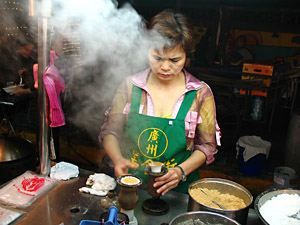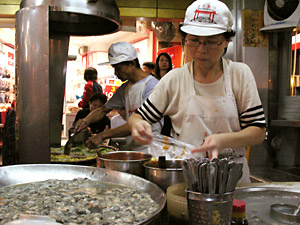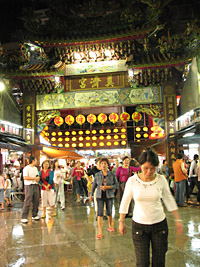Night Markets
We always had dinner plans during our limited time in Taipei, so it was hard to eat in the night markets as much as I would like. My mom and I planned a full meal around Keelung, my brother and I took several for the team by picking up snacks in Guangzhou after we'd already had dinner, but when we visited Shilin we were too full to do anything but shop. We stopped by Snake Alley, also known as the Huaxi Tourist Night Market. If that "tourist" moniker doesn't explain everything, let me say the only reason to go there is to watch snakes be cruelly skinned alive as part of some gruesome pseudo medicine show.

 |
 |
 |
The best thing about the night markets are the xiaochi, or small eats, on offer. Some of these dishes are common, like oyster pancakes, but sometimes a market develops a new famous dish not seen elsewhere, like the "fried sandwich" we tried in Keelung.
In Guangzhou market near the famous Longshan Temple, we tried sweet steamed rice cakes stuffed with peanut or black sesame, cakes made from an eggy batter encasing custard, and Japanese octopus balls, known as takoyaki. Of course we've had takoyaki before, but in New York they are literally $1 per ball. In Guangzhou market, it's about $1.50 for 8. Delicious and perfectly crispy. The eggy cakes are one my dad's favorite street snacks, but my brother and I were less impressed. The rice cakes were good but not quite what we were craving, namely mogi, glutinous rice balls with fillings. (Mogi are not sold on the street). This market featured a whole kids' arcade section, and was extremely crowded.
 |
| The "Miao Kow" |
The main food stalls have recently been renovated, with signs printed clearly in both English and Chinese. It's extremely unlikely to find a vendor that speaks English, but at least non-Chinese will be able to guess what they're getting! My mom and I started with the oyster pancakes, a very typical Taiwanese xiaochi. The pancake is made with sweet potato starch and egg, which turns into a glutinous mass suorrounding very lightly cooked oysters. Messy but delicious, for about 50NT. We grabbed a sack of grilled Chinese sausage (more sweet than savory), getting 4 with extra garlic for 20NT. A freshly-made papaya milkshake cost only 40NT, and a yummy portion of fried fishcakes was 30NT. The "fried sandwich" my cousin had so heartily recommended was basically a hero roll deep-fried, with cold cuts, veggies and an overabundance of Miracle Whip stuffed in. It was most mystifying, both in execution and popularity, with the clamoring crowd taking tickets for a place in line.
Taipei these days is modern, glitzy, and pricey. Night markets are a great way to see the real Taipei, a city that lives on the streets, stays up late, looks for a good bargain and places a premium on excellent food.